The state of California boasts its biological diversity. Because the state has such a huge diversity of climates and ecosystems, California is also home to a variety of flora and fauna. From forests to deserts and everything in between, California has it all. Unfortunately, many invasive species also call this beautiful state home. Invasive species will out-compete native species and harm the ecology of the habitats in California. By recognizing invasive species, you can play a crucial part in preventing these harmful species from devastating the environment.
Here are 10 invasive species in California that you should know.
Channeled Apple Snail (Pomacea canaliculata)
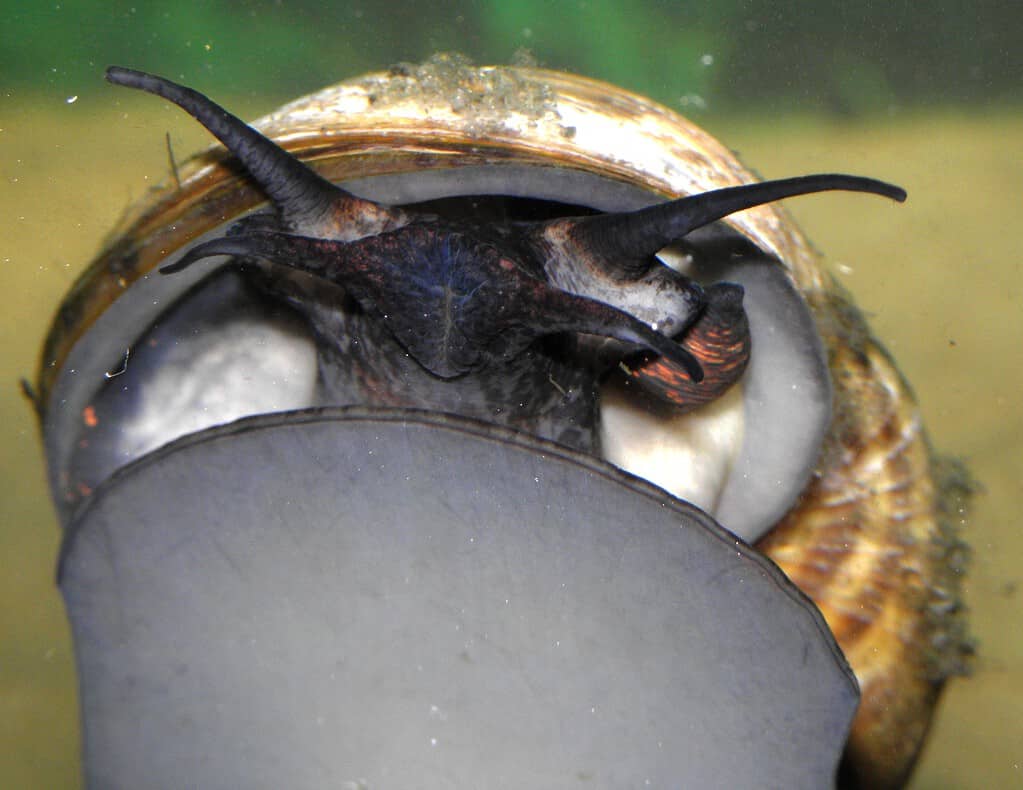
The channeled apple snail has a snorkel and gills that allow them to breathe underwater.
©CHUCAO / CC BY-SA 3.0 – License
This freshwater snail is native to the waters of South America, specifically Argentina, Uruguay, and Brazil. But since, it has made its way to other regions of the world, including Asia, Europe, and North America. The channeled apple snail is a large species of snail. Its shell can reach sizes up to 2.4 inches in diameter, and its body can grow over 3 inches long. They can be light to dark brown in color and sometimes black. Interestingly, they feature a distinctive snorkel that emerges once the snail is submerged in water, and they also have a set of gills. This allows them to breathe underwater when they are too deep to use their snorkel.
This snail species has a large appetite and feeds on aquatic plant life such as rice, water lettuce, algae, and other snail eggs. The channeled apple snail is considered invasive in California because of its ability to reproduce rapidly. This leads to a high population that makes it difficult for native species to compete. They also cause damage to aquatic crops and irrigation systems.
The California Department of Fish and Wildlife recommends a few different ways to control the spread of these invasive snails, including removing adults and their eggs, crushing any found egg masses, or spraying the egg mass with a powerful stream of water to disrupt their growth cycle.
Chinese Mitten Crab (Eriocheir senensis)
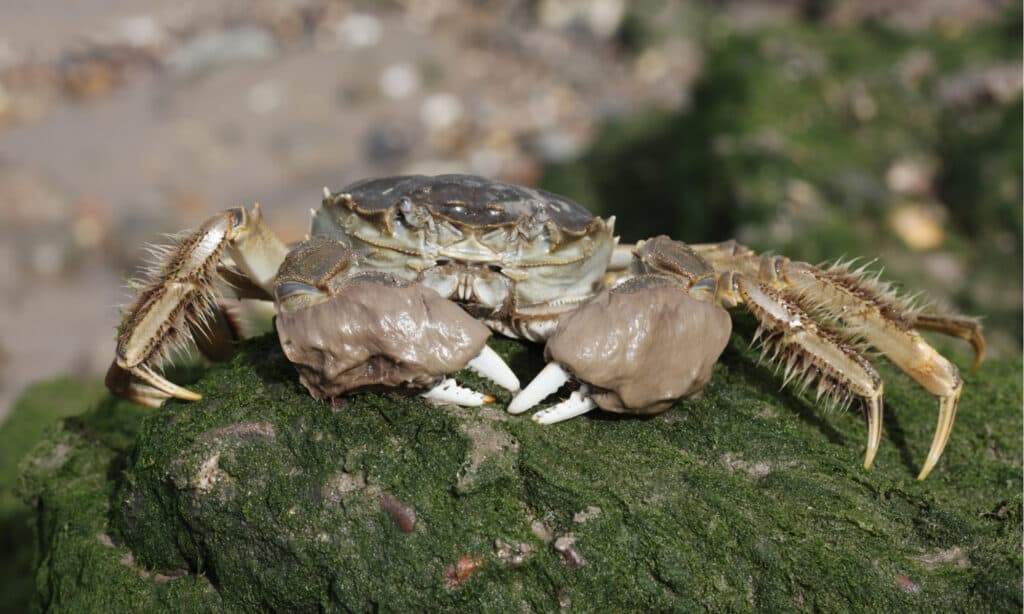
Due to the harm caused to riverbanks and native species, Chinese mitten crabs are invasive in California.
©Erni/Shutterstock.com
Chinese mitten crabs are native to the rivers of Eastern Asia, specifically China and Korea. They have since been introduced to various regions around the world, including Europe and the United States, and have found their way to California’s waters. These crabs are olive-green in color and can grow up to 4 inches wide. They have distinctive furry claws that resemble a pair of mittens, giving them their name.
Chinese mitten crabs are omnivorous and will eat various plants and animals. This includes algae, small invertebrates, small fish, and other crustaceans. This crab species is considered invasive in California due to the harm it causes to riverbanks and the native species that live there. They will often out-compete these native inhabitants for both food and habitat.
The use of traps and physical barriers are proven methods to keep these crabs away from certain areas. Educating the public about the harm these crabs cause is another important method for controlling their population in California.
African Clawed Frog (Xenopus laevis)
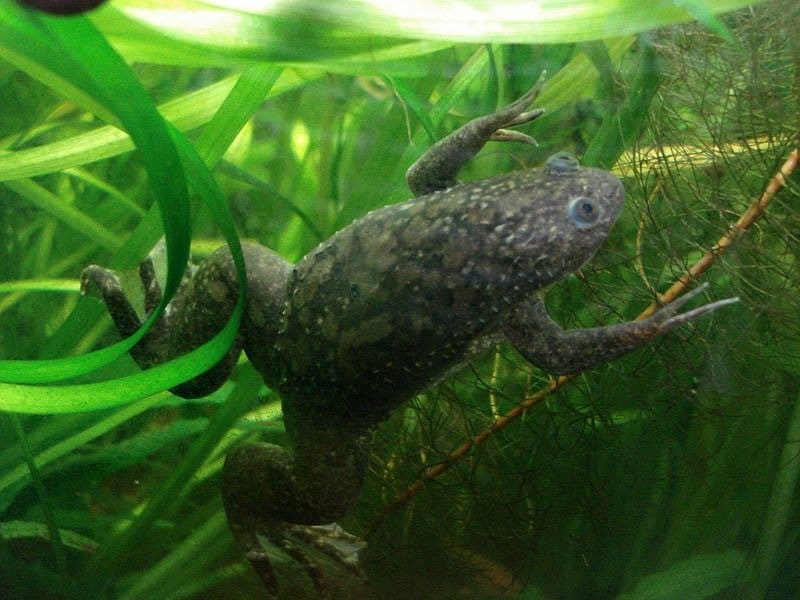
A carnivorous amphibian, the African clawed frog is a vector for parasites and diseases.
©Pouzin Olivier / CC BY-SA 3.0 – License
The African clawed frog is an amphibian that is native to Africa. These frogs have small heads and flattened bodies. The skin of the African clawed frog is smooth and greenish-grey in color with a white underbelly. Some have mottled skin. These frogs are around 4.7 inches in length and weigh around 7 ounces. The distinguishing feature of these frogs is their claws on their hind feet. Each hind foot has three short claws, which are used to tear apart food.
The African clawed frog is carnivorous and will eat anything it can fit in its mouth. The diet of this frog includes small fish, insects, spiders, frogs, worms, and more. They are considered an invasive species because of their voracious appetite and feeding behavior. African clawed frogs prey on and out-compete native frogs and other species. These frogs also serve as a vector for parasites and diseases which could be transmitted to other species. Lastly, the African clawed frog also secretes skin toxins that can harm native species.
In California, if you see an African clawed frog, you must report the sighting to the CDFW invasive species program.
American Bullfrog (Lithobates catesbeianus)
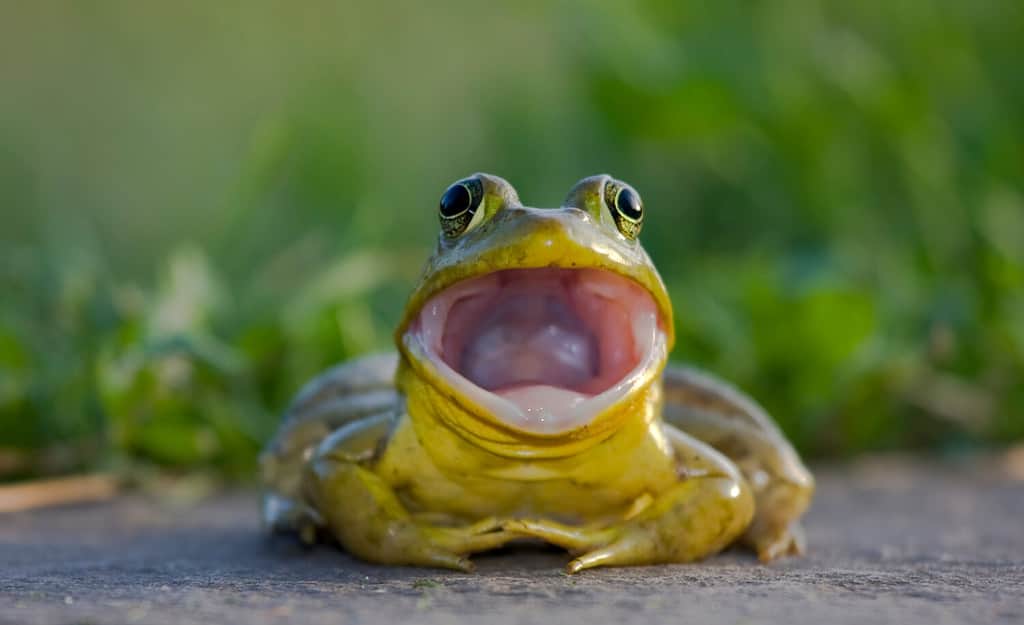
Make sure to report any sightings of the American
bullfrog
in California!
©Tau5/Shutterstock.com
The American bullfrog is a large frog species native to the eastern parts of North America. These frogs can grow between 3.6 and 6 inches in length and can weigh between 0.5 and 1.5 lbs. The skin of the American bullfrog is smooth and olive-green or brownish-green in color. The underbelly is white, and the back of the frog is blotched with dark patches.
The American bullfrog has a varied diet. The diet includes insects, spiders, small fish, other amphibians, and more. They have voracious appetites, and larger frogs can even eat birds, bats, rodents, snakes, and turtles! The American bullfrog is invasive because they prey on and out-compete native frogs and other species. These frogs are also known carriers of chytrid fungus. This fungus is the leading cause of the decline of native amphibian populations all around the world!
In California, if you come across an American bullfrog, report it to the CDFW invasive species program. This way, with your help, the state can monitor the population of this invasive species.
Red-Eared Slider (Trachemys scripta elegans)
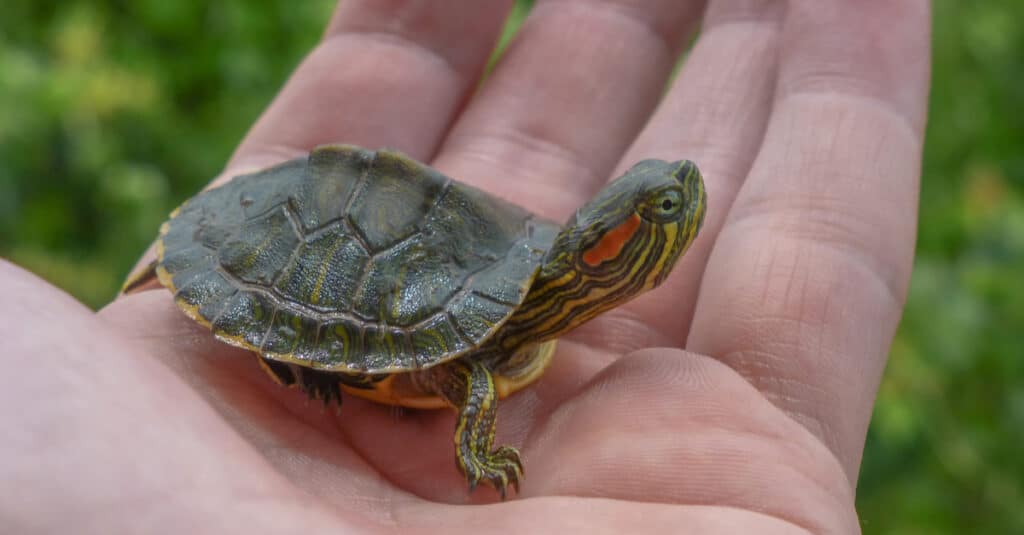
Although cute, red-eared sliders are actually an invasive species in California.
©iStock.com/Funkuokando Nin
Red-eared sliders are medium-sized turtles. These freshwater turtles are native to the southern parts of the United States. These creatures have been introduced to many counties throughout California. The shell and skin of the turtle are olive to brown with yellow stripes. The bottom of the shell is generally yellow. These turtles have a unique red stripe behind each of their eyes, hence their name. Red-eared sliders can grow between 5 and 11 inches in length.
The red-eared slider is an invasive species because it competes with native species for food and habitat. These turtles are also known vectors for disease and can transmit bacteria and parasites to other species and humans. Furthermore, the red-eared slider reproduces 6 times a year, containing up to 30 eggs – this means the population of this species grows pretty rapidly when introduced!
To control the red-eared slider populations, there is a ban on the sale and distribution of this species. However, if you come across an opportunity to own one, do not take it or purchase it unless you can care for it for its entire lifetime. If you can no longer keep your red-eared slider, make sure that you give it away instead of releasing it or relocating it. In fact, it is illegal to release the red-eared slider into the state’s waters. If you do observe a red-eared slider out and about in California, make sure to report your sightings for tracking purposes.
Brown-Headed Cowbird (Molothrus ater)
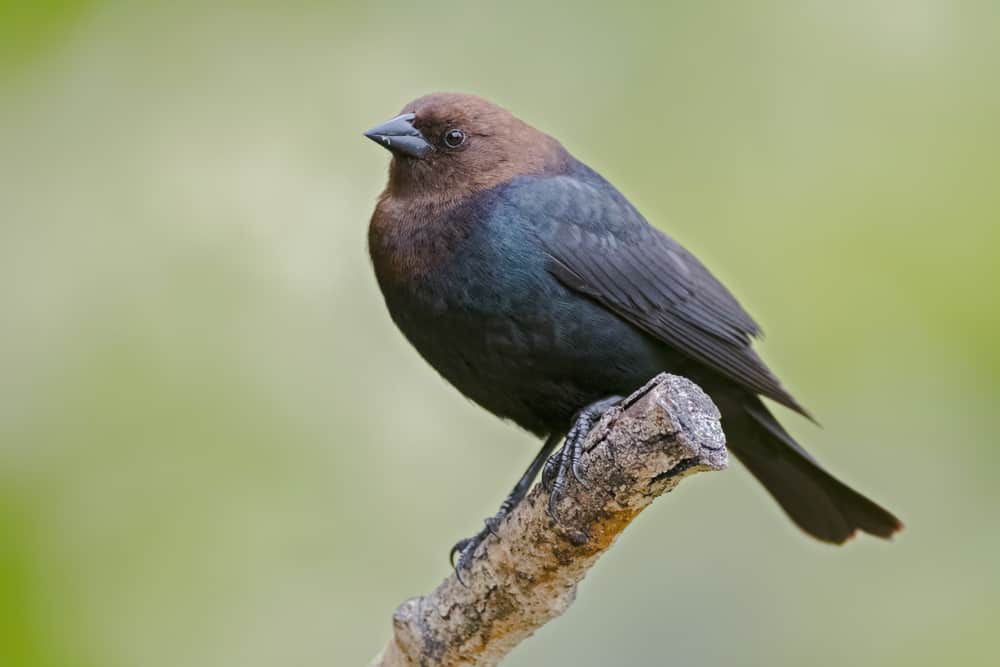
Remove any brown-headed cowbird eggs from nests!
©punkbirdr/Shutterstock.com
The brown-headed cowbird is a brood-parasitic bird that is native to North America. Because of their migratory lifestyle, they travel across the continent during the winter and summer months and will then find their way into California. Male brown-headed cowbirds, as their name implies, have a brown neck and head with a glossy black body. On the other hand, female brown-headed cowbirds have dull grey bodies with streaks underneath.
Brown-headed cowbirds feed on seeds, insects, and fruits, as well as a variety of plants. Due to their brood-parasitic nature, they are considered an invasive species in California. These birds will lay their eggs in another bird’s nest, which will then hatch and be raised as one of their own by the host. Cowbird chicks grow much faster than the native species and will aggressively compete with their nest mates for food. This results in the native birds facing a population decrease.
A good method to limit the brown-headed cowbird population is to remove cowbird eggs from nests. Another method is to trap the adults to prevent them from breeding or laying. Raising awareness of these birds and their behavior also helps to gain helpful reports of sightings in the state.
Canada Thistle (Cirsium arvense)
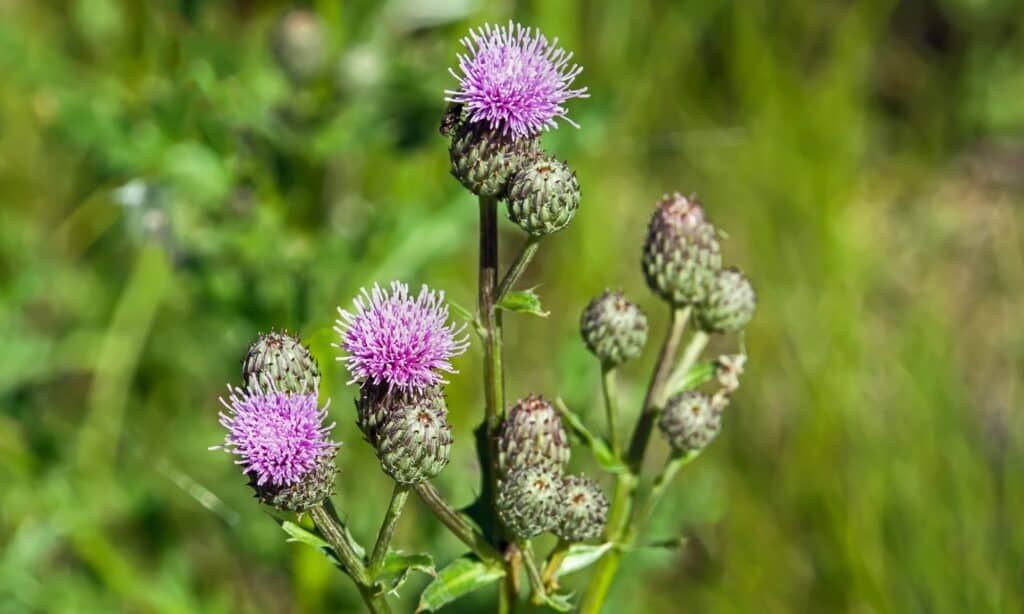
A perennial, the Canada thistle competes with native plants for nutrients, water, and light.
©iStock.com/williamhc
The Canada thistle is a perennial native to Europe and Asia. This plant can grow up to between 3 and 5 feet tall. This plant has an extensive creeping root system that can reach depths of up to 15 feet. This makes eradication of the plant extremely difficult. The Canada thistle produces flowers that are white to purple in color, and the leaves are spiny, loped, and can grow up to 8 inches long and 1.5 inches wide.
The Canada thistle is invasive in California because it competes with native plant species. As the plant competes for nutrients, light, and water, it causes a loss in crops. This plant also increases infections from abrasions, which can be economically damaging to ranchers. And finally, the Canada thistle is a known host species for agricultural insects and disease pests.
Control measures for the Canada thistle include mechanical, biological, and chemical methods. Mechanical measures, such as mowing, can be used to reduce nutrient storage of the plant. Biological measures, such as the Canada thistle stem weevil, can be used to kill the plant. Chemical measures include the use of herbicides which could allow control over an invasion.
Dyer’s Woad (Isatis tinctoria)

Originally from Eurasia, Dyer’s woad can lower species diversity.
©Burning Bright/Shutterstock.com
Dyer’s woad is a flowering plant that originated from Eurasia. This plant is large and can grow up to 4 feet in length. Dyer’s woad also has a taproot that can grow between 3 and 5 feet long. The basal leaves of the Dyer’s woad are stalked, hairy, and bluish-green in color. These leaves can grow up to 7 inches long. The flowers of the Dyer’s woad are found in clusters and are small and yellow. The seeds produced are encased with protective silicles, which means the seeds can survive for more than 8 years.
Dyer’s woad can thrive in a variety of environmental conditions. It can be found in rangelands, pastures, and forests. This plant is considered invasive as it outcompetes native grasses and infests grain and alfalfa fields. Although not toxic to animals, the plant is not readily grazed on. Dyer’s woad can also lower species diversity and decrease land value.
Management for Dyer’s woad includes prevention, cultural control, biological control, and chemical control. Cultural control methods include seed destruction and solar tenting. Biological control by using a rust fungus can help reduce Dyer’s woad populations. Chemical control by using effective herbicides can also be effective but may take years of applications to control populations. Although all these measures can help control Dyer’s woad, the most effective control measure is prevention, which can be done through careful monitoring and sanitation.
Perennial Pepperweed (Lepidium latifolium)
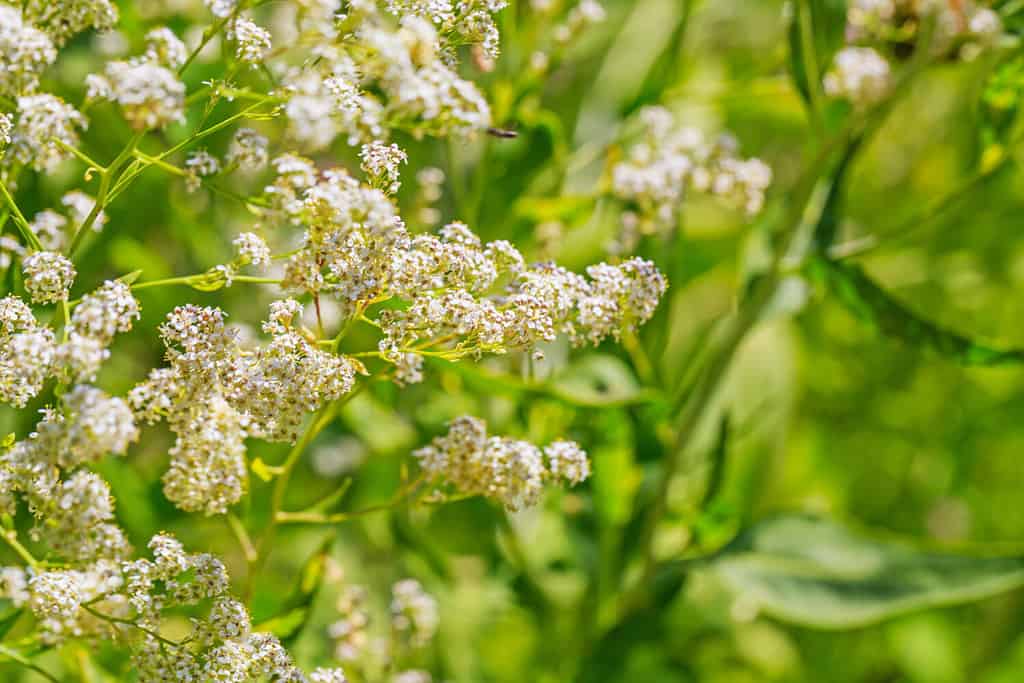
Growing up to 6.6 feet tall, the perennial pepperweed can displace other vegetation and wildlife.
©nnattalli/Shutterstock.com
Perennial pepperweed is a plant native to southern Europe and western Asia. This plant is a member of the mustard and cabbage family and can grow up to 6.6 feet. The perennial pepperweed plant has many woody stems and produces small white flowers that form dense clusters. The leaves are waxy and green to gray-green in color, and the fruit is small and contains just two seeds. The roots of the perennial pepperweed are long, thick, and extensive, with some roots reaching a depth of 10 feet or more!
The perennial pepperweed is considered invasive because it displaces desirable vegetation and wildlife. This plant spreads easily and can infest riparian areas or even irrigation structures. Furthermore, the plant’s roots don’t hold soil well, allowing river banks to erode. The plant also reduces forage quality in hay and pasture.
Control methods for perennial pepperweed include mechanical, cultural, and chemical measures. Mechanical measures include pulling, cutting, and disking. Cultural measures include using cattle, sheep, and goats to graze on the plant. Chemical measures include the use of herbicides to control perennial pepperweed populations.
Purple Loosestrife (Lythrum salicaria)
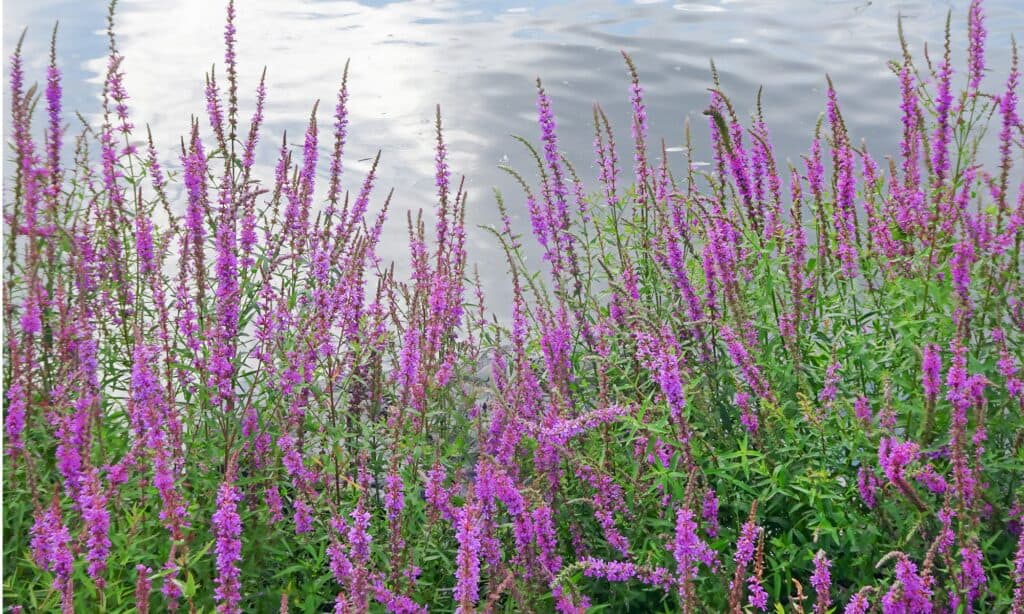
A flowering plant, purple loosestrife is an invasive species in California.
©iStock.com/Natalia Kazarina
Purple loosestrife is a flowering plant native to Eurasia. This plant is very large and can grow between 3 ft 3 in and 6 ft 7 in length. This plant forms clonal colonies that can be over 4 ft 11 inches wide! The purple loosestrife gets its name from its purple to magenta flowers. The fruit produced contains many seeds that are dispersed by water and wind.
The purple loosestrife is an invasive species in California because it disrupts the ecology of wetland sites. This plant displaces native vegetation and wildlife. The purple loosestrife can also clog irrigation systems. Unfortunately, this plant is not very palatable, so it negatively affects the wetland pastures for grazing as well.
A few control methods can be used to help control the populations of this invasive plant. Measures include mechanical, cultural, biological, and chemical methods. Mechanical measures include pulling, cutting, and disking. Cultural methods include flooding and black plastic mulch. Biological measures include using several non-native insects, including the golden loosestrife beetle. And finally, chemical measures include the use of herbicides.
Summary of Invasive Species in California
| Species | Origin |
|---|---|
| Channeled Apple Snail | Argentina, Uruguay, Brazil |
| Chinese Mitten Crab | China, Korea |
| African Clawed Frog | Africa |
| American Bullfrog | North America |
| Red-Eared Slider | Southern United States |
| Brown-Headed Cowbird | North America |
| Canada Thistle | Europe, Asia |
| Dyer’s Woad | Europe, Asia |
| Perennial Pepperweed | Europe, Western Asia |
| Purple Loosestrife | Europe, Asia |
The photo featured at the top of this post is © iStock.com/Funkuokando Nin
Thank you for reading! Have some feedback for us? Contact the AZ Animals editorial team.







